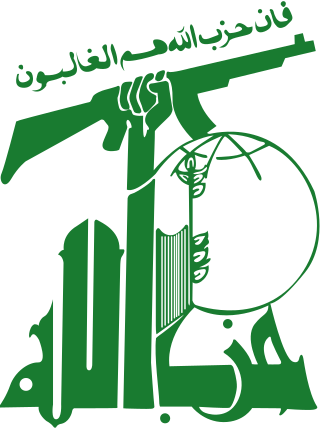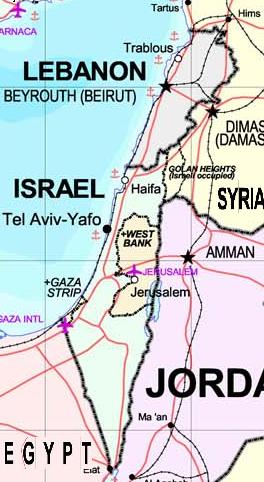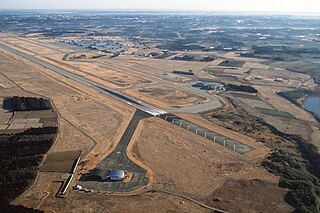
Hezbollah is a Lebanese Shia Islamist political party and militant group, led since 1992 by its Secretary-General Hassan Nasrallah. Hezbollah's paramilitary wing is the Jihad Council, and its political wing is the Loyalty to the Resistance Bloc party in the Lebanese Parliament.
Al-Qa'im is an Iraqi border town located nearly 400 km (248 mi) northwest of Baghdad near the Syrian border and situated along the Euphrates River, and located in the Al Anbar Governorate. It has a population of about 74,100 and it's the center of the Al-Qa'im District.
A Military Transition Team or Transition Team, commonly abbreviated as MiTT, in the context of the United States Military, is a 10 – 15 soldier team that trains foreign national and local security forces. The term has been used in the "War on Terror" to designate groups training the Iraqi Security Forces in particular. By comparison, Afghan Army and other Afghan security forces are mentored and trained by US Embedded Training Teams (ETTs) and the Operational Mentoring and Liaison Teams (OMLTs) of other nations.
This is a timeline of events related to the 2006 Lebanon War.

The Israeli–Lebanese conflict, or the South Lebanon conflict, is a series of military clashes involving Israel, Lebanon and Syria, the Palestine Liberation Organization, as well as various militias and Militants acting from within Lebanon. The conflict peaked in the 1980s, during the Lebanese Civil War, and has abated since.

Hezbollah, the Lebanese Shia Islamist political party and militant group, has an exceptionally strong military wing, thought to be stronger than the Lebanese Army, and equivalent to the armed strength of a medium-sized army. A hybrid force, the group maintains "robust conventional and unconventional military capabilities", and is generally considered the most powerful non-state actor in the world.

The 2006 Lebanon War, also called the 2006 Israel–Hezbollah War and known in Lebanon as the July War and in Israel as the Second Lebanon War, was a 34-day military conflict in Lebanon, northern Israel and the Golan Heights. The principal parties were Hezbollah paramilitary forces and the Israel Defense Forces (IDF). The conflict started on 12 July 2006, and continued until a United Nations-brokered ceasefire went into effect in the morning on 14 August 2006, though it formally ended on 8 September 2006 when Israel lifted its naval blockade of Lebanon. Due to unprecedented Iranian military support to Hezbollah before and during the war, some consider it the first round of the Iran–Israel proxy conflict, rather than a continuation of the Arab–Israeli conflict.

Kata'ib Hezbollah —or the Hezbollah Brigades—is a radical Iraqi Shiite paramilitary group which used to be part of the Popular Mobilization Forces, staffing the 45th, 46th, and 47th Brigades. During the Iraq War (2003–11), the group fought against Coalition forces. It has been active in the War in Iraq (2013–2017) and the Syrian civil war (2011–present). The group was commanded by Abu Mahdi al-Muhandis until he was killed in a US drone attack in 2020. Thereafter, he was replaced by Abdul Aziz al-Muhammadawi, as the new leader of the Popular Mobilization Forces (PMF). KH seeks to establish an Iran-aligned government in Iraq, expel American forces from the country, and advance the regional and international interests of Iran in Iraq and the region. The group is responsible for killing hundreds of U.S. soldiers and takes a central part in carrying out attacks against U.S. targets in Iraq and acts as part of the Axis of Resistance. Kata'ib Hezbollah is directly subordinate to Iranian Islamic Revolutionary Guard Corps's (IRGC) Quds Force and operates under its instructions and guidance.

K-1 Air Base, or Kaywan, is a former Iraqi Air Force base and military base in the Kirkuk Governorate of Iraq. It was captured by Coalition forces during Operation Iraqi Freedom in 2003, later served as the headquarters of the 12th Division of the Iraqi Army. In 2014 it was taken over by the Kurdish Peshmerga. On October 16, 2017, the base was taken back by Iraqi special forces during the Battle of Kirkuk.
The 2012–2014 Quneitra Governorate clashes began in early November 2012, when the Syrian Army began engaging with rebels in several towns and villages of the Quneitra Governorate. The clashes quickly intensified and spilled into the UN-supervised neutral demilitarized zone between Syrian controlled territory and the Israeli-occupied Golan Heights.

The Iran–Israel proxy conflict, also known as the Iran–Israel proxy war or Iran–Israel Cold War, is an ongoing proxy war between Iran and Israel. Supporters of Israel cite threats and hostility by Iran's leaders against Israel, and their declared objective to dissolve it. On the other hand, supporters of Iran cite Israel's status as a settler colony in the Arab region as a basis for Iran's aggression towards Israel.
The following lists some remarkable events that happened in 2014 in Lebanon on a monthly basis.

Hezbollah involvement in the Syrian Civil War has been substantial since the beginning of armed insurgency phase of the Syrian Civil War in 2011, and evolved into active support for Ba'athist government forces and troop deployment from 2012 onwards. By 2014, Hezbollah was deployed across Syria. Hezbollah has also been very active in preventing Al-Nusra Front and Islamic State penetration into Lebanon, being one of the most active forces in the Syrian Civil War spillover in Lebanon.
The Deir ez-Zor offensive (2018) was launched by the Islamic State of Iraq and the Levant against government-held areas throughout the Deir ez-Zor Governorate of Eastern Syria. During the offensive, on 8 June, ISIL managed to penetrate the city of Abu Kamal, capturing several parts of it.
The Iran–Israel conflict during the Syrian civil war refers to the Iranian–Israeli standoff in and around Syria during the Syrian conflict. With increasing Iranian involvement in Syria from 2011 onwards, the conflict shifted from a proxy war into a direct confrontation by early 2018.
On 29 December 2019, the United States conducted airstrikes against Kata'ib Hezbollah's weapons depots and command centers in Iraq and Syria, reportedly killing at least 25 militiamen and wounding 55 more. The U.S. Department of Defense said the operation was in retaliation for repeated attacks on Iraqi military bases hosting Operation Inherent Resolve (OIR) coalition forces, particularly the 27 December 2019 attack on a Kirkuk airbase that left an American civilian contractor dead. Kata'ib Hezbollah, an extremist Shi'ite militia funded by Iran, denied any responsibility for the attacks.
The 2020 Camp Taji attacks were rocket attacks that took place on 11 March and 14 March 2020, targeting Camp Taji, north of Baghdad, in Baghdad Governorate, which hosts Coalition and United States Forces in Iraq.

In December 2019, Iraq and the United States began discussing the partial withdrawal of American combat troops from Iraq. In January 2020, during massive protests in Iraq, and following an escalation of tensions between the United States and Iran, the Iraqi Council of Representatives passed a non-binding measure to "expel all foreign troops from their country," including American and Iranian troops. Following the vote, U.S. President Donald Trump initially refused to withdraw from Iraq, but began withdrawing forces in March.

On February 25, 2021, the United States military carried out an airstrike on a site which it believed to have been occupied by Iranian-backed Iraqi militias operating from across the border in eastern Syria. The unilateral operation was in retaliation for multiple rocket attacks against U.S. forces in Iraq ten days prior and was the first known offensive military operation carried out under U.S. president Joe Biden.









